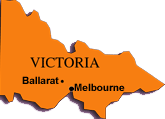The Gold Rush in USA and Australia
Word spreads fast when gold is discovered! People rush to where its been found, seeking their fortunes. Young and old - from all walks of life - they leave their families, jobs and businesses and rush to the latest find, to strike it rich. This is a ‘gold rush’ and the places where gold is found are called ‘goldfields’.
In the 1800s, there were several famous gold rushes in the USA and in Australia.
U.S.A. - California
In 1848 a carpenter named John Marshall found gold at Sutter’s Mill, near Sacramento. News of his find spread to the East Coast of America, and in 1849 thousands of people rushed to California seeking their fortune. They were called the “forty-niners”. At first, they lived in tents on the goldfield, then towns grew around them.
The new miners searched for flakes of gold, by sifting soil at the bottom of streams with a shallow pan. After a few years, this type of gold was harder to find, and heavy machines were needed to dig deeper underground. Companies were set up to organise the work and the profits – and individual miners moved on to the next big strike.
Gold and silver mining
California is famous for gold rushes, and its neighbouring State, Nevada, for its silver booms. But California also has a rich history of silver mining. There were busy silver towns in the Sierra Nevada mountain ranges and in the Mojave Desert. One of the most famous was Silver Mountain City in Alpine County.
Miners and merchants
Most miners stayed poor, because only a few of them found large amounts of gold. The people who most often made money on the gold fields were the merchants who sold supplies to the miners. Levi Straus made his fortune by selling one item of clothing. Do you know what that was?
When the gold and silver ran out, the miners and merchants moved on. The boomtowns became ghost towns. Today, you can see the ruins of buildings that were once home to thousands of people – the only evidence now of a proud town. But some towns have been luckier. They’ve been restored as tourist attractions, to show us how the miners lived and dreamed of being rich.
Australia - Victoria
 In 1850 Edward Hargraves came back to Australia from
the goldfields of California. He hadn’t struck it rich, and he was
convinced that gold could be found in the countryside around Bathurst,
his home town in the State of New South Wales.
In 1850 Edward Hargraves came back to Australia from
the goldfields of California. He hadn’t struck it rich, and he was
convinced that gold could be found in the countryside around Bathurst,
his home town in the State of New South Wales.
A year later he found gold. Then large deposits were discovered near Ballarat and Bendigo in the State of Victoria. The next big gold rush had begun. During the 1850s, Australia’s population trebled to 1.1 million people. Many “forty-niners” left the gold fields of California and joined the thousands of dreamers who came from England.
Flakes and nuggets of gold
Unlike California, where flakes of gold had been found in streambeds, miners sometimes found huge nuggets of gold in Victoria. Panning and sluicing for gold was still done, but most miners dug into the ground. They were called ‘diggers’ – a nickname that’s still given to Australians today.
Holes of all shapes and sizes were dug, sometimes with only six feet of earth between them. The diggers scraped down through the earth until they reached layers of clay – called ‘bottom’. Then they tunnelled until they could go no further – usually because they ran into another digger’s tunnel coming the other way.
As in California, the merchants who sold food and equipment to the diggers found that business was profitable, and many grew rich. Chinese men and women travelled from Asia to make their home in Australia. They were experts at growing food and plants, and they supplied these to the merchants.
England’s rule over Australia
Australia was an English colony. A Goldfields Commissioner, appointed by the English government, administered gold mining activities. The Commissioner brought in a compulsory licensing system that was very harsh. All miners had to buy a monthly licence before they could dig for gold.
This and other injustices led to a rebellion by the miners at Eureka Hill, outside Ballarat. They armed themselves, built a wooden defence barrier called a stockade – and flew their flag of independence, the Southern Cross. The military overran the Eureka stockade and many men were killed and wounded on both sides. Licence fees were abolished.
Australia still mines gold and is the third largest producer in the world today, after South Africa and the U.S.A

